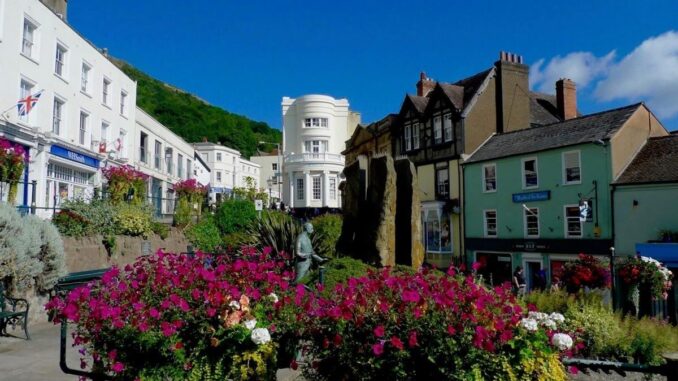
The flutes, oboes, clarinets, bassoons, horns, harps, drums and strings are well-known. But not so much the landscape that inspired them.
The stirring, uplifting sounds are very familiar – the Cello Concerto (1919), Nimrod from the choral work, Enigma Variations (1898-99), The Dream of Gerontius (1900), the Violin Concerto for Fritz Kreisler, (1909-10), Salut d’Amour (1888), Symphony No 1 (1908), and of course, the official second British National Anthem.
But not so the sights, the country walks and rural rides of the Land of Hope and Glory.
The son of a piano tuner and sheet music salesman, Sir Edward Edgar (1857-1938) is the most famous English classical music composer. His Pomp and Circumstance March No. 1 in D had its premiere, along with March No. 2, in Liverpool in 1901. Its trio “Land of Hope and Glory” section was used in the Coronation Ode for King Edwards VII and has become an iconic part of the Last Night of the Proms.
March No. 1 was the first piece in the recessional music for the coronations of George VI and Elizabeth II, followed by March No. 4. At the royal wedding of Prince Charles and Lady Diana Spencer in 1981, Pomp and Circumstance No. 4 served as the recessional. It was also the first piece in the recessional music for the coronation of Charles III in 2023.
His high school and college “Graduation March” was first played on 28th June 1905 at Yale University, where the composer received an honorary Doctor of Music.
“Land of Hope and Glory” was composed by Edward Elgar in 1901, with lyrics by A.C. Benson added in 1902. Elgar was knighted in 1904.

The Proms began in 1895. Impresario Robert Newman, the manager of London’s Queen’s Hall, wanted to offer a series of “promenade concerts” (in French “se promener” meaning “to walk”) so people could enjoy music while they walked. Standing places would be available as well as more expensive seats. The annual eight-week BBC Proms season now comprises ninety concerts.
Conductor Henry Wood commented:
“Little did I think then that the lovely broad melody of the trio would one day develop into our second national anthem.”
However, as a tourist destination, the Malvern Hills remains in the shadow of the neighbouring Cotswolds. But they are a designated Area of Outstanding Natural Beauty. During the nineteenth century, Great Malvern became a popular centre for hydrotherapy. Holyrood House for women and Tudor House for men became the luxury residential spas to visit to take the therapeutic waters of St Anne’s Well.
Eight miles (13 km) south-west of the city of Worcester, the name Malvern derives from Mælfern, “the bare hill”, now called Worcester Beacon. Vineyards such as The Two Beacons make award- winning English wines. One of the best places to stay and eat is the Georgian manor house, The Cottage in the Wood.
The Elgar Route is a 40-mile (64 km) drive passing some key landmarks from The Master of The King’s Musick and Music Laureate of the British people’s life. The title was conferred in 1924.
As well as being the Professor of Music at Birmingham University, at one time or another during his career Elgar held posts such as the conductor of the attendants’ band at the Worcester and County Lunatic Asylum in Powick and professor of the violin at the Worcester College for the Blind Sons of Gentlemen.
The trail, which you can do in a Morgan car rented from the Morgan Car Company in Malvern, takes you from Elgar’s birthplace in the Firs, Broadheath, near Worcester, to various homes In Herefordshire and Worcestershire, such as Napleton Grange near Kempsey, the Enigma fountain and Elgar statue on Belle Vue Terrace in the Great Malvern town centre, the view from British Camp Iron Age hill fort, the Elgar memorial window in Worcester Cathedral, the former Elgar Brothers shop at No 10 High Street, Worcester, St. George’s Roman Catholic Church in Sansome Place where Elgar succeeded his father as the organist and a commemorative plaque outside the Alice Ottley Girls School, now part of the Royal Grammar School on The Tything, where Elgar was a violin teacher. And the composer’s grave at St Wustan’s Church in Malvern Wells.

The Malvern Hills have literary connections too.
William Langland’s poem The Visions of Piers Plowman (1362) was inspired by the landscape in which the writers C.S. Lewis and J.R.R Tolkien also found inspiration. Some believe Tolkien’s White Mountains of Gondor to be inspired by the area and the first glimpse of Narnia in The Chronicles of Narnia to be inspired by the snow and the gas lights of Great Malvern, seen by Lewis when he left the Unicorn pub with The Lord of the Rings author.
Another artistic attraction is The Theatre of Small Convenience which is the Guinness Book of World Records’ smallest theatre in the world. Located in a former Victorian public convenience on Great Malvern’s Edith Walk, the venue has a capacity of 12 people.
Over four million people will watch the Last Night of the Proms live on television and over five thousand will sit. stand and “promenade” in London’s 1871 Royal Albert Hall on Saturday 13th September 2025.
They will sing along with Elgar’s Pomp and Circumstance March No. 1, and Land of Hope and Glory, as well as the equally patriotic Henry Wood’s Fantasia on British Sea Songs (1910), James Thomson and Thomass Arne’s “Rule, Britannia!” (1740), William Blake (1804-1880) with music by Sir Hubert Parry’s (1918) “Jerusalem” and the first British royal national anthem, “God Bless Our King”, composer unknown but first adopted in 1745.
For more information on The Malverns, Malvern Hills and surrounding area, please visit: www.visitthemalverns.org and @visitthemalverns on Facebook and Instagram.
Author Bio:
Kevin Pilley is a former professional cricketer and chief staff writer of PUNCH magazine. His humour, travel, food and drink work appear worldwide, and he has been published in over 800 titles.
Photographs courtesy of Visit The Malverns





Be the first to comment